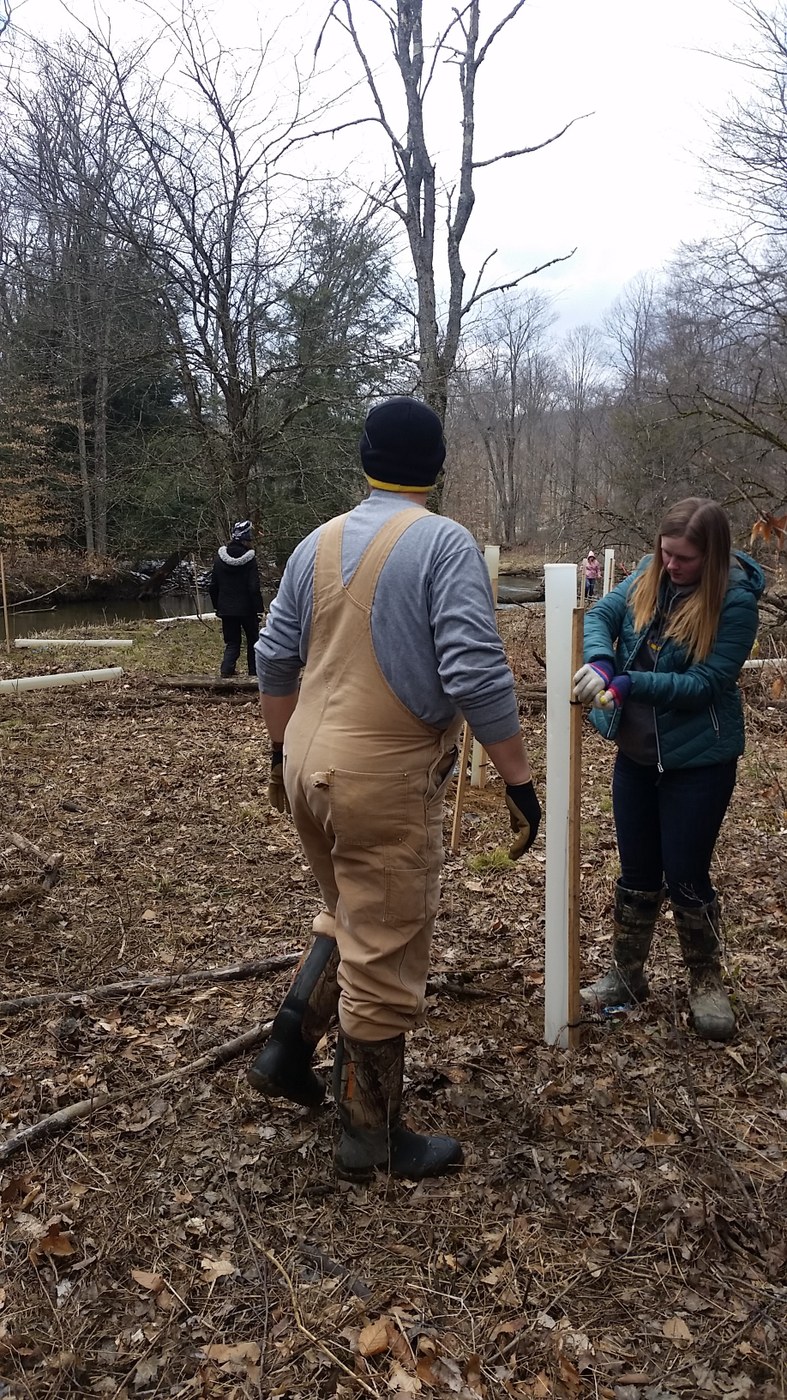Posted: February 8, 2023
Late April into early May is a great time to plant trees and shrubs for many reasons. Check out this article for resources and thoughts on planning a spring tree planting.

This spring tree planting on a cold day in early April incorporated tree tubes to protect seedlings planted as a riparian buffer.
By Jeff Osborne, Forest Stewardship Program Associate
Late April into early May is a great time to plant trees and shrubs for many reasons. You may have been cooped up all winter and feel the need for strenuous outdoor activity. Deciduous seedlings are dormant and evergreen seedlings are less active, decreasing the stress of transplanting and increasing survival. April, May, and June tend to have ample precipitation, increasing survivorship and reducing the need for supplemental waterings. A spring planting also affords you the opportunity to see the plants quickly break bud and put on growth. They may even flower if you are planting larger-sized stock. Many nurseries are set up for spring and fall sale and deliveries of large amounts of stock for immediate planting, and smaller volumes of containerized stock throughout the year. So, the best time to set up a planting plan for a spring planting is not on Arbor Day. If you have not already started planning, the best time is now into early January.
Tree plantings fail every year due to predictable (not enough light, herbivory, poor species selection) and unpredictable events (weather events, insect, or disease outbreaks). Proper planning can help mitigate losses. Newly planted trees and shrubs should have sunlight most of the day, so they can survive and quickly grow tall enough to be out of deer browse height and have a diameter sufficient to resist girdling by rodents. Once you have identified an area that has sufficient light you can concentrate on the soil. If the area has a multitude of plant species already growing, the soil will probably be sufficient to grow your new plants. If there are only a few species growing, or you know of past use, like strip mining, that makes the area less hospitable, soil testing is advised to determine the pH of the soil. Penn State offers soil testing and many county conservation districts sell soil test kits. Soil pH will inform you which species are likely to grow better in the area. Soil texture will also influence which species you should choose. Dig around a bit in the area to be planted. If the soil is mostly clay, or very sandy or stony, you should choose species that will grow well in those types of soils. Soil moisture also needs to be considered. Soil moisture is affected by soil texture, aspect, and terrain position. South-facing slopes tend to be drier during the growing season than northern slopes or flat areas. Ridge tops tend to be droughty. Some trees and shrubs cannot handle soils that are frequently saturated with water, which tends to happen in low-lying areas or near bodies of water.
Once you have an idea of the pH, texture, and moisture trends of your soil, you can follow species selection guides to choose species that will meet your objectives for the planting and more closely match the conditions of your site. Whether your objectives are cover for animals, a wind screen, wildlife food, increasing tree and shrubs species diversity, a combination of the above, or something else entirely, you should plan to plant several different species. Choosing only one or two different species can leave your planting vulnerable to mass mortality events. Many pests and diseases only affect a limited number of species; having tightly spaced groups of only one or two species can lead to a pest spreading more readily. While it may be aesthetically pleasing to have nice straight rows of a single species like white spruce or arborvitae planted, a needle cast disease could wipe out most of your spruces or bag worms could kill groups of your arborvitae.
With your species selection in place, start looking for planting stock. In addition to selling soil test kits, many county conservation districts have spring tree sales and begin taking orders in early winter with delivery in April. Conservation districts re-sell commercial nursery stock. Many commercial nurseries in Pennsylvania sell containerized stock, with fewer selling bare root seedlings. The PA Game Commission’s Howard Nursery grows seedlings for wildlife habitat plantings on State Game Lands. Their excess stock will be sold to the public beginning on Monday, January 9, 2023, with distribution in mid to late April. Bare root seedlings need to be kept cool and moist until planting, or they can dry out and die. After you order your seedlings, you may have a few months to wait until they are ready to pick-up. This is a good time to think about site preparation, planting methods, and methods of protecting the new plants. If you are planning a larger scale tree planting, or are unsure about an aspect of the process, there are Bureau of Forestry Service Foresters covering each county who are available to assist.
James C. Finley Center for Private Forests
Address
416 Forest Resources BuildingUniversity Park, PA 16802
- Email PrivateForests@psu.edu
- Office 814-863-0401
- Fax 814-865-6275
James C. Finley Center for Private Forests
Address
416 Forest Resources BuildingUniversity Park, PA 16802
- Email PrivateForests@psu.edu
- Office 814-863-0401
- Fax 814-865-6275

